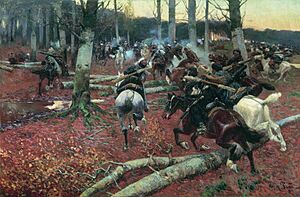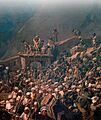Caucasian War facts for kids
Quick facts for kids Caucasian War |
|||||||||
|---|---|---|---|---|---|---|---|---|---|
| Part of the Russian conquest of the Caucasus | |||||||||
 Franz Roubaud's A Scene from the Caucasian War |
|||||||||
|
|||||||||
| Belligerents | |||||||||
|
|
||||||||
| Commanders and leaders | |||||||||
|
|
|||||||||
| Strength | |||||||||
| 1817–1864: 1819: 50,000 1857: 200,000 1862: 60,000 |
1817–1864: 15,000–25,000 35,000–40,000 |
||||||||
| Casualties and losses | |||||||||
The Caucasian War was a long military conflict in the 1800s. It happened between the Russian Empire and different groups of people living in the North Caucasus region. These groups, like the Adyghe, Chechens, and Dagestanis, fought back against Russia's expansion.
The war involved many battles. The Russian Imperial Army and Cossack settlers tried to take control of the land. The conflict was split into two main parts. The Georgian Military Road in the middle of the Caucasus mountains divided the fighting. To the west was the Russo-Circassian War. To the east was the conquest of Chechnya and Dagestan. Other areas, like parts of Georgia, Armenia, and Azerbaijan, became part of Russia earlier. This happened after Russia fought wars with Persia and the Ottomans.
Contents
A Look at the Caucasian War
The Caucasian War lasted for many years. It took place during the rule of three Russian Tsars: Alexander I, Nicholas I, and Alexander II. Important Russian commanders included Aleksey Yermolov and Mikhail Semyonovich Vorontsov.
Famous Russian writers also knew about this war. Leo Tolstoy learned a lot about war for his book War and Peace from these events. The poet Alexander Pushkin wrote about it in his poem "The Prisoner of the Caucasus." Another poet, Mikhail Lermontov, even fought in a battle near the Valerik River. This battle inspired him to write a poem about it.
The Russian armies were made up of many different people. They included ethnic Russians, Cossacks, Armenians, Georgians, and even some Muslim soldiers. These Muslim soldiers sometimes helped Russia by talking to other Muslim groups in the Caucasus.
Early Years of Conflict
The Russian expansion faced strong resistance from the local people. The first part of the war ended around 1825. This was when Tsar Alexander I died. This early period did not bring much success for Russia. This was surprising, especially after their big victory against Napoleon in 1812.
From 1825 to 1833, there was less fighting in the Caucasus. Russia was busy with other wars. They fought against Turkey and Persia. After winning these wars, Russia returned its focus to the North Caucasus. They continued their efforts to control the region.
Fierce Resistance and Key Leaders
The local groups in the North Caucasus fought back bravely. Important leaders like Ghazi Mollah and Hamzat Bek led the resistance. Later, Imam Shamil became the main leader. He led the mountain people from 1834 until he was captured in 1859.
In 1843, Shamil launched a big attack. He targeted Russian outposts in Avaria. His forces killed many Russian soldiers and captured most of their forts. Shamil also tricked the Russians by pretending to invade north. This helped him capture a key mountain pass. In 1845, Shamil's forces had a big success. They held their ground against a major Russian attack led by Prince Vorontsov.
During the Crimean War (1853–1856), Russia made a temporary peace with Shamil. But the fighting started again in 1855. The war in the Caucasus finally ended between 1856 and 1859. A large Russian army, led by General Baryatinsky, finally broke the resistance of the mountain people.
The war in the eastern North Caucasus ended in 1859. The Russians captured Shamil. He was forced to surrender and promise loyalty to the Tsar. Then, he was sent to live in Central Russia. However, the war continued in the western North Caucasus. The Circassians kept fighting. The war officially ended on May 21, 1864, when Tsar Alexander II declared it over.
What Happened After the War
After the war, many Circassians and other Muslim people faced a difficult time. They were forced to leave their homes. This movement of people is called Muhajirism. Most of them moved to the Ottoman Empire. Some also went to Persia.
The population of some groups changed a lot. For example, the number of people in Greater and Lesser Kabarda dropped significantly. Before the war, there were about 350,000 people. By 1818, this number was only 50,000. Other groups also saw big changes in their populations. The number of Circassians in the North Caucasus decreased from 40% of the total population in 1795 to 25% in 1858.
Images for kids
-
Caucasian tribesmen fight against the Cossacks, 1847
-
Shamil (front page). Illustrated London News of December 24, 1859.
See also
- Russian conquest of Chechnya and Dagestan
- Russo-Circassian War
- Chechen-Kazikumukh war























